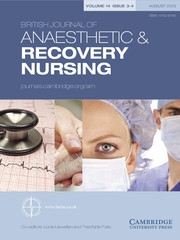Article contents
Effect of Pre-warming on Reducing the Incidence of Inadvertent Peri-operative Hypothermia for Patients Undergoing General Anaesthesia: A Mini-review
Published online by Cambridge University Press: 03 April 2013
Abstract
This mini-review aims to assess the effect pre-warming has on reducing the incidence of inadvertent peri-operative hypothermia for patients undergoing general anaesthesia.
A search of the MEDLINE and EMBASE databases, as well as hand-searching through the reference lists of key articles, was undertaken. Articles were included on the basis that the studies were randomised controlled trials, undertaken on patients who were undergoing surgery under general anaesthesia and were pre-warmed for 60 minutes using forced-air warming systems. This resulted in two articles being critically appraised and reviewed using guidelines based on those given in Greenhalgh and Donald (2000).
The results for both of these studies showed that statistically significant differences were seen in core body temperature, with analysis of variance used to test for the significant differences between the sample means. The findings were also clinically significant, as a small drop in temperature as a result of anaesthesia and surgery can lead to IPH, and with pre-warming this can be avoided.
The studies that were used in this review both reported that pre-warming patients for 60 minutes pre-operatively had both a statistically significant and clinically significant effect. This means that patients should receive a period of pre-warming before surgery in addition to being warmed peri-operatively, in order to reduce any drop in potential temperature that can lead to IPH.
- Type
- Original Article
- Information
- Copyright
- Copyright © British Association of Anaesthetic and Recovery Nursing 2013
References
- 6
- Cited by


